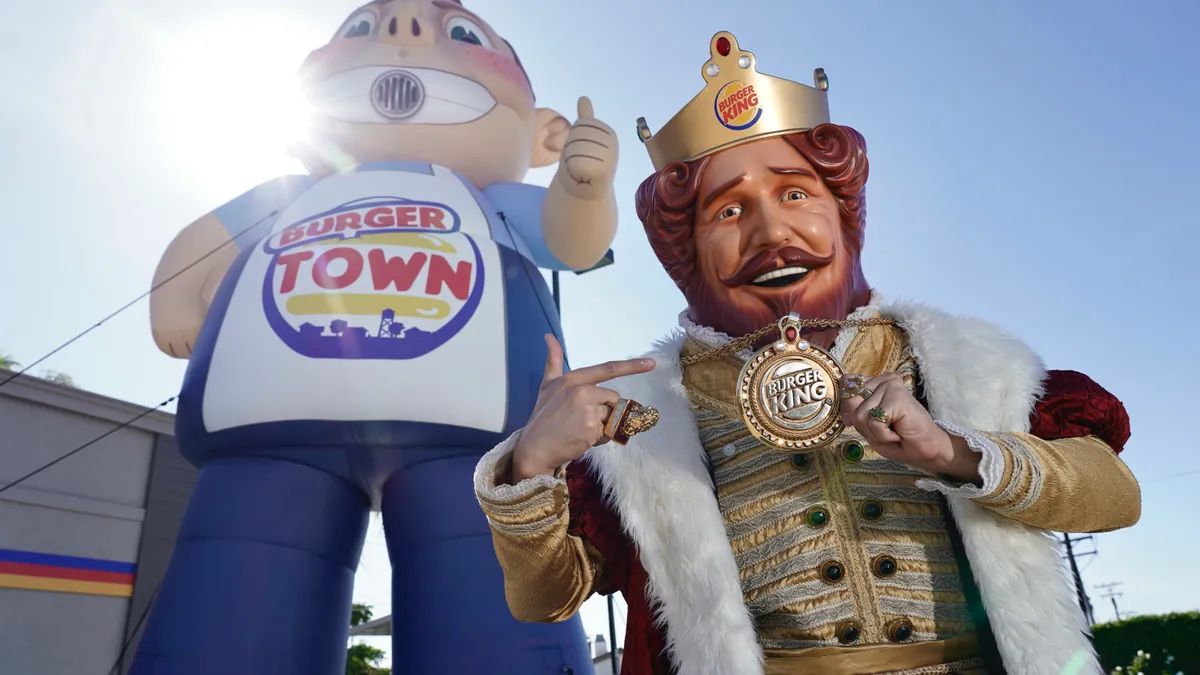Mobile has become a mainstay menu item for many marketers in the quick-service restaurant (QSR) space this year, especially as third-party apps like Uber Eats and Grubhub continue to close in on the lucrative delivery opportunity. To meet consumer demands and remain a top-of-mind leader among cutthroat competition, Burger King has employed a mobile-first mindset when it comes to its marketing. This year, the fast food giant honed in on building customer loyalty through dunking on rivals like McDonald's, wedging itself into timely pop culture moments and driving app downloads through smartphone-centric campaigns.
Burger King differs from competitors by balancing this mobile tech with insights that show its customers are more focused on its "indisputable price point," according to brand consultant Jono Bacon.
"The modern consumer is used to brands harnessing these devices, and Burger King stepped it up a notch," he told Mobile Marketer. "Critically though, and where many others fail, they knew how to incentivize their audience to participate via the most valuable thing to their audience: low-cost food."
"For too long Burger King was seen as the place you go when somewhere else is closed. They fundamentally focused on refreshing the brand to something that people care about again."

Jono Bacon
Jono Bacon Consulting, CEO
Despite its marketing cheekiness sometimes coming with consequences — a U.K. advertising watchdog banned the chain's milkshake-related tweet this fall — Burger King's success in using mobile technology and location data demonstrates how savvy brands can creatively tap into consumers' attachment to smartphones and lift sales. In October, the Restaurant Brands International-owned company reported its highest quarterly comparable sales growth since 2015.
Convenience-centered capabilities
Much of Burger King's marketing strategy this year has focused on driving app downloads through linking creative campaigns to its mobile platform, meeting the growing consumer demand for convenience via technology.
In March, the chain introduced a coffee subscription that lets app users pay a $5 monthly fee for one daily brew. The brand has leaned into trolling competitors for years, with its BK Café Coffee subscription marketed as "the price of a large cappuccino from Starbucks." Similarly, Burger King ran a mobile campaign that let app users in Brazil virtually set fire to the ads of its fast food rivals. As a video spot shows, the app used augmented reality to overlay digital images of a blazing inferno burning away competitors' ads to reveal a mobile coupon for a free Whopper. The creative stunt engaged app users with an amusing activity while promoting the BK Express service that lets customers skip the line to retrieve their food. Pushing a coupon to users' phones is a unique way to deliver value to customers and steer them into restaurants.
"A run-of-the-mill app that offers online or expedited ordering just wasn't going to cut it," Bacon said. "This is the key: Technology provides fast-access to your consumers, but many companies fail to focus enough on the core incentive to get people to install and use the app."
By centering its 2019 strategy around app downloads and continuously running campaigns that require the mobile hub, Burger King made its app stickier for repeat users. This demonstrates how a mobile-first mindset can help marketers creatively cut through the clutter of traditional ads and one-time stunts.
Several of these app-powered marketing gambits, such as #EscapeTheClown and "Whopper Detour," tapped geolocation to further personalize messaging by targeting consumers based on their physical location.
"Burger King customers have literally no need to install an app: They show up, order a burger, and leave. They don't have the level of brand commitment a company such as Apple or Google has to make digital a normal part of the customer experience," Bacon said. "It shows just what is possible when you blend the right kinds of incentives with great awareness and marketing, and a low-barrier to entry."
Delivery battleground
These mobile-minded initiatives illustrate how Burger King is vying to appeal to tech-savvy consumers. A number of QSRs are battling to reach valuable millennial and Gen Z groups through interactive campaigns as well as convenience-focused features like mobile ordering, payment and delivery.
A renewed focus on delivery underpinned several stunts by Burger King this year. In May, the chain tested a program to deliver food to motorists stuck in Mexico City traffic. "Traffic Jam Whopper" let drivers order from the chain's app and get their items delivered to their car by motorcycle, sparking a 63% jump in delivery orders in the test's first week and a 44-fold surge in app downloads. In October, Burger King debuted a 30-second video spliced from Los Angeles customers' doorbell footage to promote its nationwide expansion of Uber Eats delivery.
The promotional video, "Traffic Jam Whopper" and Burger King's other creative efforts come as delivery and mobile features become an essential focus for QSRs responding to shifting consumer tastes. The National Restaurant Association found that more than 60% of millennial diners want restaurants to use technology that makes ordering and payment easier, and to make takeout and delivery more convenient for their on-the-go lifestyles.
"For too long Burger King was seen as the place you go when somewhere else is closed," Bacon said. "They fundamentally focused on refreshing the brand to something that people care about again."




 Read more
Read more










